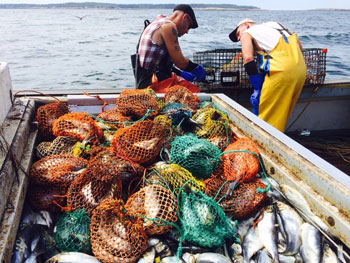Herring Cutbacks Drive Need for
Safe-bait Protocols
by Laurie Schreiber

“It’s estimated that Maine’s lobster fishery will have a roughly 50-million-pound bait deficit going into next year’s lobster season. Maine has already developed a protocol for identifying alternative bait sources and classifying potential bio-hazards.” –Pat Keliher, Maine DMR and ASMFC ©Joel Woods photo.
NEW YORK, N.Y.—At its Oct. 22 meeting, the Atlantic States Marine Fisheries Commission (ASMFC) discussed the development of protocols for identifying alternative bait sources in the face of cutbacks of quotas in the Atlantic herring fishery for 2019 through 2021, according to ASMFC information.
This could have impacts on the lobster fishery, given that herring is a preferred bait source.
Pat Keliher, vice-chairman of the ASFMC and commissioner of the Maine Department of Marine Resources, said it’s estimated that Maine’s lobster fishery will have a roughly 50-million-pound bait deficit going into next year’s lobster season.
Maine has already developed a protocol for identifying alternative bait sources and classifying potential bio-hazards, Keliher said. Maine’s protocol was established in order to reduce the risk of viral agents, parasites, and nuisance species being brought via bait into nearby waters. The protocol was developed through a collaboration between the fishing industry, bait dealers, the DMR, and the University of Maine. As a result, the DMR developed a list of approved baits. Since then, the DMR has used a committee of industry, university, and government interests that provides risk assessments and recommendations regarding prospective bait sources and their risk for pathogens, he said.
“This is one of the most
serious issues that we face.”
– Pat Keliher, Commissioner,
Maine DMR
The ASMFC considered several actions for moving the discussion forward. A non-binding resolution would encourage states to develop their own protocols. Or states could independently develop their own bait protocols and use the ASFMC as a forum. Or the ASMFC could development an amendment to incorporate bait protocol into its management plan.
“There’s a lot of work associated with this from a state perspective,” said Keliher. “But we have a real threat here, to the Gulf of Maine and beyond, with the use of baits that potentially have these pathogens associated with them.”
He continued, “This is one of the most serious issues that we face. If we’re allowing the use of baits that potentially have the ability to transmit disease to native fisheries, that’s problematic. I’d say at least start with the Gulf of Maine, but we should be looking coastwide, in my mind.”
“I think the only way we’re going to get some control over this is to start an amendment,” said ASMFC commissioner Ritchie White. “The amendment could create measures that are flexible enough that we can react to changing conditions, so it doesn’t box us in too much.”
ASFMC commissioner David Borden agreed it’s a serious issue and proposed the ASMFC consider both short-term and long-term solutions.
“I don’t think we’re all
factoring in the
timing element.”
– David Borden,
ASMFC Commissioner
“I don’t think we’re all factoring in the timing element,” Borden said. “This is going to play out over a relatively short period of time, when there’s going to be a high demand of bait.” But an amendment takes a lot of time to develop, he said. He proposed putting together a working group to develop a short-term protocol and also a long-term coastwide strategy. “This is a really complicated issue,” he said. “We need a short-term strategy and a longer-term strategy.”
Keliher made a motion that states within the jurisdiction of the ASMFC’s lobster management plan “initiate a resolution to address the threats to interstate commerce that is created by the use of lobster biat that is sourced form domestic and foreign locations that are known to harbor viral, bacterial, parasitic, and invasive agents that could pose a risk to lobster and other indigenous species. Such measures must ensure that the use of such baits will be prohibited by December 2020.”
The motion carried unanimously.
